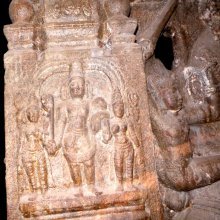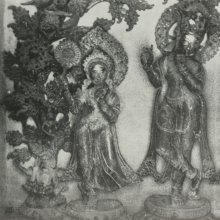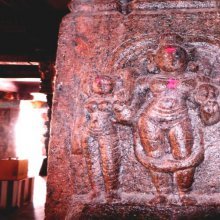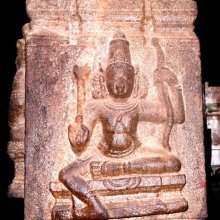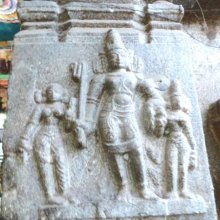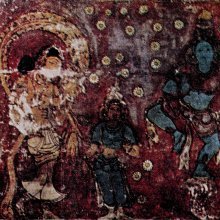Satyabhama, Satyabhāmā, Satya-bhama: 12 definitions
Introduction:
Satyabhama means something in Hinduism, Sanskrit, Jainism, Prakrit. If you want to know the exact meaning, history, etymology or English translation of this term then check out the descriptions on this page. Add your comment or reference to a book if you want to contribute to this summary article.
Images (photo gallery)
(+2 more images available)
In Hinduism
Vaishnavism (Vaishava dharma)
Source: ISKCON Press: GlossarySatyabhāmā (सत्यभामा).—One of the principal queens of Lord Kṛṣṇa during His pastimes in the city of Dvārakā.
Source: Pure Bhakti: Brhad BhagavatamrtamSatyabhāmā (सत्यभामा) refers to:—Śrī Kṛṣṇa’s favorite queen in Dvārakā and the daughter of Satrājit. (cf. Glossary page from Śrī Bṛhad-bhāgavatāmṛta).

Vaishnava (वैष्णव, vaiṣṇava) or vaishnavism (vaiṣṇavism) represents a tradition of Hinduism worshipping Vishnu as the supreme Lord. Similar to the Shaktism and Shaivism traditions, Vaishnavism also developed as an individual movement, famous for its exposition of the dashavatara (‘ten avatars of Vishnu’).
Purana and Itihasa (epic history)
Source: archive.org: Puranic EncyclopediaSatyabhāmā (सत्यभामा).—The wife of Śrī Kṛṣṇa. Introduction. Once Śrī Kṛṣṇa himself said about the previous birth of Satyabhāmā. There was an occasion for saying that. (See full article at Story of Satyabhāmā from the Puranic encyclopaedia by Vettam Mani)
Source: Cologne Digital Sanskrit Dictionaries: The Purana IndexSatyabhāmā (सत्यभामा).—(see Satyā) a daughter of Satrājit (Bhangakāra, Matsya-purāṇa). The latter had mistakenly suspected Kṛṣṇa of having murdered his brother, and to make amends, gave his daughter in marriage to Kṛṣṇa though Akrūra and others had sought her hand before. Mother of 6 sons and 4 daughters among whom were Bhānu and Bhaumarikā. Terrified at the murder of her father by1 Śatadhanvan (s.v.) she caused the dead body to be preserved in oil and went to Hāstinapuram to inform Kṛṣṇa. Saw Syamantaka with Akrūra and coveted it. Welcomed to Indraprastha by Draupadī;2 narrated to her the circumstances under which she married Kṛṣṇa;3 went with Kṛṣṇa during his expedition to Naraka's city, and then to Indra's abode. Embraced and blessed by Aditī; complained to Kṛṣṇa that Indrāṇī did not accord her proper welcome and insisted on the Pārijāta being taken to Dvārakā. Defeated Kubera who attracted her husband and was praised by Kṛṣṇa for her valour;4 observed Kalyāṇini vratam;5 took away the Pārijāta; Indra fought for it but was defeated; Satyabhāmā gave it back to him saying that she wanted to teach a lesson to Indrāṇī; returned to Dvārakā with the Pārijāta presented by Indra.6
- 1) Bhāgavata-purāṇa X. 56. 39-44: Brahmāṇḍa-purāṇa III. 71. 57-80. Vāyu-purāṇa 96. 55-78, 233: Viṣṇu-purāṇa IV. 13. 71. 151, 154. Matsya-purāṇa 45-21: 47-13-19 Viṣṇu-purāṇa IV, 13. 64-6: 32. 1.
- 2) Bhāgavata-purāṇa X. 57. 7-8, 41 [2]:
- 3) Ib. X. 71. 42-3: 83. 9, 14.
- 4) Ib. X. 59. 2; 38-40 [65 (v) 2, 9-10], [28-29], [66 (v) 11-20]: Viṣṇu-purāṇa IV. 15. 35: V. 28. 5: 29. 14 and 35, 30. 26-7:
- 5) Matsya-purāṇa 69. 60.
- 6) Viṣṇu-purāṇa V. 30. 36 to end; 31. 11.

The Purana (पुराण, purāṇas) refers to Sanskrit literature preserving ancient India’s vast cultural history, including historical legends, religious ceremonies, various arts and sciences. The eighteen mahapuranas total over 400,000 shlokas (metrical couplets) and date to at least several centuries BCE.
In Jainism
General definition (in Jainism)
Source: archive.org: TrisastisalakapurusacaritraSatyabhāmā (सत्यभामा) or Satyā is the daughter of Jambukā and Satyaki who became the wife of Kapila (son of Dharaṇījaṭa), according to chapter 5.1 [śāntinātha-caritra] of Hemacandra’s 11th century Triṣaṣṭiśalākāpuruṣacaritra: an ancient Sanskrit epic poem narrating the history and legends of sixty-three illustrious persons in Jainism.
Accordingly, “[...] at an auspicious moment Satyaki married Satyabhāmā and Kapila with suitable ceremonies. Honored by the citizens in all the city as much as Satyaki, daily he (Kapila) enjoyed pleasures with good-tempered Satyabhāmā. The people gave him special money, rice, etc, on all the festival-days, thinking, ‘He is more to be honored even than Satyaki’. Living in this way. best of living Brāhmans, Kapila became well-endowed with money as well as good qualities.”.
Source: academia.edu: Tessitori Collection ISatyabhāmā (सत्यभामा) was the rival of Rukmiṇī, who married Kṛṣṇa, according to the Vedabhīvīvāha by Premarāja (dealing with the lives of Jain female heroes), which is included in the collection of manuscripts at the ‘Vincenzo Joppi’ library, collected by Luigi Pio Tessitori during his visit to Rajasthan between 1914 and 1919.—Background story:—Vedabhī, Sanskrit: Vaidarbhī, here refers to Rukmiṇī, who married Kṛṣṇa. all the figures evoked in this narrative poem are contemporary with Neminātha and Kṛṣṇa. Among them Satyabhāmā, who is Rukmiṇī’s rival, is present.

Jainism is an Indian religion of Dharma whose doctrine revolves around harmlessness (ahimsa) towards every living being. The two major branches (Digambara and Svetambara) of Jainism stimulate self-control (or, shramana, ‘self-reliance’) and spiritual development through a path of peace for the soul to progess to the ultimate goal.
Languages of India and abroad
Sanskrit dictionary
Source: DDSA: The practical Sanskrit-English dictionarySatyabhāmā (सत्यभामा).—Name of the daughter of Satrājit and the favourite wife of Kṛṣṇa; (it was for her that Kṛṣṇa fought with Indra and brought the Pārijāta tree from the Nandana garden and planted it in her garden).
Satyabhāmā is a Sanskrit compound consisting of the terms satya and bhāmā (भामा).
Source: Cologne Digital Sanskrit Dictionaries: Shabda-Sagara Sanskrit-English DictionarySatyabhāmā (सत्यभामा).—f.
(-mā) One of Krishna'S wives and daughter of Satrajit. E. satya true, bhāma beautiful, fem. form.
Source: Cologne Digital Sanskrit Dictionaries: Cappeller Sanskrit-English DictionarySatyabhāmā (सत्यभामा).—[feminine] [Name] of a wife of Kṛṣṇa.
Source: Cologne Digital Sanskrit Dictionaries: Monier-Williams Sanskrit-English DictionarySatyabhāmā (सत्यभामा):—[=satya-bhāmā] [from satya > sat] f. ‘having true lustre’, Name of a daughter of Satrā-jit and one of the eight wives of Kṛṣṇa (she is described as having promoted the quarrels of the Yādavas), [Mahābhārata; Harivaṃśa; Purāṇa etc.]
Source: Cologne Digital Sanskrit Dictionaries: Yates Sanskrit-English DictionarySatyabhāmā (सत्यभामा):—(mā) 1. f. One of Krishna's wives.
[Sanskrit to German]
Sanskrit, also spelled संस्कृतम् (saṃskṛtam), is an ancient language of India commonly seen as the grandmother of the Indo-European language family (even English!). Closely allied with Prakrit and Pali, Sanskrit is more exhaustive in both grammar and terms and has the most extensive collection of literature in the world, greatly surpassing its sister-languages Greek and Latin.
See also (Relevant definitions)
Partial matches: Bhama, Satya.
Starts with: Satyabhamabhyudaya, Satyabhamabhyudayakavya, Satyabhamabhyudayavyakhyana, Satyabhamaparinaya, Satyabhamavilasa.
Full-text (+66): Satrajit, Bhimarika, Satyatmaja, Tamrajaksha, Satyabhamaparinaya, Satyabhamavilasa, Pratibhanu, Satrajiti, Prabhanu, Shribhanu, Bhairika, Satyabhamabhyudayakavya, Satyabhamabhyudayavyakhyana, Bhama, Satyabhamabhyudaya, Subhanu, Jalamdhama, Satya, Kshupa, Tamravaksha.
Relevant text
Search found 44 books and stories containing Satyabhama, Satya-bhama, Satya-bhāmā, Satyabhāmā; (plurals include: Satyabhamas, bhamas, bhāmās, Satyabhāmās). You can also click to the full overview containing English textual excerpts. Below are direct links for the most relevant articles:
Garga Samhita (English) (by Danavir Goswami)
Verses 6.8.10-11 < [Chapter 8 - The Marriages of All the Queens]
Verse 1.3.37 < [Chapter 3 - Description of the Lord’s Appearance]
Verse 4.19.95 < [Chapter 19 - A Thousand Names of Srī Yamunā]
The Bhagavata Purana (by G. V. Tagare)
Chapter 59(a) - The Pārijāta Tree Taken by Śrī Kṛṣṇa < [Book 10 - Tenth Skandha]
Chapter 59(b) - Satyabhāmā defeats Gods < [Book 10 - Tenth Skandha]
Chapter 59(c) - Pārijāta planted in Satyabhāmā’s Palace < [Book 10 - Tenth Skandha]
The Taking of Parijata < [Fifth Section]
The Jewel Syamantaka < [Fourth Section]
The Killing of Narakasura < [Fifth Section]
Harivamsha Purana (by Manmatha Nath Dutt)
Chapter 65 - Krishna Visit with Aditi < [Book 2 - Vishnu Parva]
Chapter 67 - Satyabhama’s Resentment and Keshava’s Consolation to Her < [Book 2 - Vishnu Parva]
Chapter 68 - Satyabhama’s Grief < [Book 2 - Vishnu Parva]
Mahabharata (English) (by Kisari Mohan Ganguli)
Section CCXXXIII < [Draupadi-Satyabhama Samvada]
Section CCXXXI < [Draupadi-Satyabhama Samvada]
Draupadi-Satyabhama Samvada < [Book 3 - Vana Parva]
Chaitanya Bhagavata (by Bhumipati Dāsa)
Verse 2.9.213 < [Chapter 9 - The Lord’s Twenty-One Hour Ecstasy and Descriptions of Śrīdhara and Other Devotees’ Characteristics]
Verse 1.15.51 < [Chapter 15 - Marriage with Śrī Viṣṇupriyā]
Verse 3.4.389 < [Chapter 4 - Descriptions of Śrī Acyutānanda’s Pastimes and the Worship of Śrī Mādhavendra]
